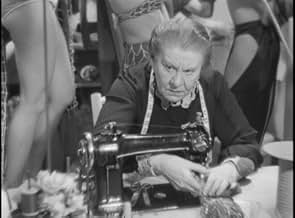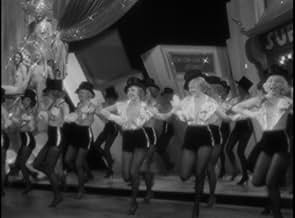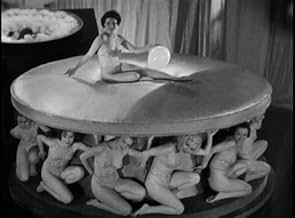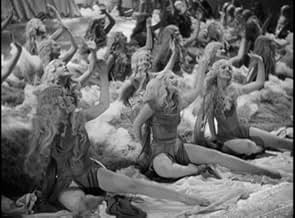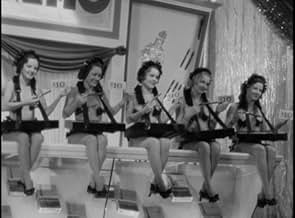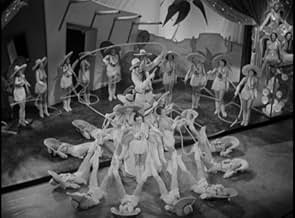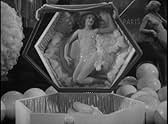PUNTUACIÓN EN IMDb
6,5/10
1 mil
TU PUNTUACIÓN
Un detective investiga una serie de asesinatos en el marco de un espectáculo musical que acaba de estrenarse.Un detective investiga una serie de asesinatos en el marco de un espectáculo musical que acaba de estrenarse.Un detective investiga una serie de asesinatos en el marco de un espectáculo musical que acaba de estrenarse.
- Dirección
- Guión
- Reparto principal
- Premios
- 1 premio en total
Charles Middleton
- Homer Boothby
- (as Charles B. Middleton)
Ernestine Anderson
- Earl Carroll Girl
- (sin acreditar)
Lona Andre
- Lona - Earl Carroll Girl
- (sin acreditar)
William Arnold
- Treasurer
- (sin acreditar)
Lucille Ball
- Earl Carroll Girl
- (sin acreditar)
Lucille Battle
- Black Dancer in Ebony Rhapsody number
- (sin acreditar)
Reseñas destacadas
This murder mystery with musical numbers is long on atmosphere and character but rather short on suspense and plausibility. Based on a stage play by Broadway showman Earl Carroll and others, it combines a whodunit plot with a backstage ambiance (a homicide investigation takes place on opening night at the theatre where a musical revue is being staged).
The cast is impressive and varied: tough-goofy Victor McLaglen as the police officer who leads the investigation and never fails to leer idiotically at whatever showgirl happens to be in sight; Jack Oakie (the prewar Jack Lemmon – or was Jack Lemmon the postwar Jack Oakie?) as the harassed director who must coordinate the staged performance as well as the chaos behind the scenes; the ever-homely Jessie Ralph as a wardrobe mistress with deep, dark secrets; Dorothy Stickney, who has a stunning close-up monologue near the end, as the tremulous maid madly in love with the male lead; Carl Brisson, the Danish star, as that very male lead, warbling the classic "Cocktails for Two" not once but twice; Kitty Carlisle, operatically delivering "Where Do They Come from and Where Do They Go" and other Johnston-Coslow songs; the glorious Gertrude Michael, who parted from us too soon, as a mean-spirited showgirl whose love for Brisson is spurned; the usually ridiculous Toby Wing who here at least is the center of a laugh-getting running joke.
When the plot complications get out of hand there is always an interesting performer or fun and tuneful musical number to distract the viewer. The film's most celebrated sequence is the "Marahuana" number, led by Michaels, but aside from its controversial history, it's really one of the lesser musical offerings. All of the songs here are staged as if they could actually have fit into a standard proscenium theatre space, as opposed to the cinematic fantasy setup of the Busby Berkeley style.
The cast is impressive and varied: tough-goofy Victor McLaglen as the police officer who leads the investigation and never fails to leer idiotically at whatever showgirl happens to be in sight; Jack Oakie (the prewar Jack Lemmon – or was Jack Lemmon the postwar Jack Oakie?) as the harassed director who must coordinate the staged performance as well as the chaos behind the scenes; the ever-homely Jessie Ralph as a wardrobe mistress with deep, dark secrets; Dorothy Stickney, who has a stunning close-up monologue near the end, as the tremulous maid madly in love with the male lead; Carl Brisson, the Danish star, as that very male lead, warbling the classic "Cocktails for Two" not once but twice; Kitty Carlisle, operatically delivering "Where Do They Come from and Where Do They Go" and other Johnston-Coslow songs; the glorious Gertrude Michael, who parted from us too soon, as a mean-spirited showgirl whose love for Brisson is spurned; the usually ridiculous Toby Wing who here at least is the center of a laugh-getting running joke.
When the plot complications get out of hand there is always an interesting performer or fun and tuneful musical number to distract the viewer. The film's most celebrated sequence is the "Marahuana" number, led by Michaels, but aside from its controversial history, it's really one of the lesser musical offerings. All of the songs here are staged as if they could actually have fit into a standard proscenium theatre space, as opposed to the cinematic fantasy setup of the Busby Berkeley style.
Thus sumptuous Paramount art deco musical is almost a definitive pre code extravaganza and is on per with WONDERBAR and FASHIONS OF 1934 and TOP HAT as the glittering perfection of code- cusp risqué showgirl and nightclub sophisticated sexiness. Made at Paramount in late 1933 and clearly designed to outshine the WB Busby Berkeley extravaganzas, this one does it with nude showgirls, drug references, weapons, a slinky killer, murder in the ceiling and dripping blood, and big stage show numbers all crammed over the orchestra pit on the opening night of a big Broadway show. I was reminded of almost every Busby Berkeley film but clearly on a lower budget with the difference being made up by having spectacular costumes. In color this film would be an enduring musical of its time. In gorgeous B&W it still rates but one can see how colorful the costumes are even in monochrome. One startling song SWEET MARIJUANA manages the unparalleled feat of including nudity drugs murder and blood all on screen during the tune. There is a hilarious and nutty island mermaid number and a fantastic and simple art deco staging of COCKTAILS FOR TWO. This film clearly influenced THE GREAT ZIEGFELD made at MGM in 1936.
Released just before the Production Code crackdown in July, 1934, Mitch Leisen's all-star Paramount musical is both leeringly suggestive -some even claim misogynistic- and a heck of a lot of fun. Two murders occur on the opening night of "Earl Carroll's Vanities" (one on-stage), but that doesn't stop the manager (Jack Oakie) from putting on a show as a lascivious police detective (Victor McLaglen) investigates. Everyone is hiding something and Gypsy Rose Lee must have seen this backstage murder mystery before she penned "The G-String Murders" as the denouement is similar, albeit more satisfying here. Gertrude Michael, as a vicious diva, stops the show (in more ways than one) with her exotic "Sweet Marijuana" number and Duke Ellington finishes with the truncated "Rape Of The Rhapsody". The hit song, "Cocktails For Two", also came from this bizarre and bawdy camp classic. Here's Louella O. Parsons in the "Los Angeles Examiner" on May 17, 1934:
Earl Carroll's hand-picked beauties' pirouette about on the Grauman United Artists screen in a fig leaf and not much else. But September Morn herself never had a better figure than these charmers, who are made up to please the eye, especially the eye of the tired businessman. But don't for a moment think Mr. Carroll's girls, au naturelle, are the only attraction. Believe it or not, MURDER AT THE VANITIES is a musical comedy thriller, if you know what I mean -a murder mystery incorporated in a musical show. It all happens on the opening night at the time the play is in progress and a search is on for a murderer. Just by way of suspense, a cop threatens to stop the show every few minutes. Victor McLaglen is something new in cops. All the time he is trying to track down the murderer, he keeps his eye fastened on the chorus beauties. The murder mystery is good with the exception of the denouement, which is pretty flat. Probably faulty direction. Dorothy Stickney, who plays the maid, is about as melodramatic as the heroine in a ten, twenty, and thirty show. For no good reason, she rates a never-ending closeup in the big dramatic scene. The girl ensembles are good, and it's a positive relief to get away from the inevitable overhead shots. The costumes are beautiful; in fact, this is a musical that Paramount can feel is really to their credit. As for Carl Brisson -well, he would be an addition to any show. Good-looking with a delightful singing voice and an easy, assured manner, he is all his press agents claim for him. I also like Kitty Carlisle, who plays the leading lady in the show. Gertrude Michael, as the deep-eyed villainess, gives an interesting if rather fictional portrayal. Jack Oakie, as the stage manager, is the same old wisecracking Jack, but we wouldn't change him. Jessie Ralph is excellent as the seamstress. Others in the cast are Charles Middleton, Gail Patrick, Donald Meek, Barbara Fritchie, Toby Wing and Lona Andre. The screen play is by Carey Wilson and Rufus King, and the direction by Mitchell Leisen. The music is by Arthur Johnstone and the lyrics by Sam Coslow. In addition to MURDER AT THE VANITIES, there is a Mickey Mouse cartoon, a Paramount Newsreel, and a two-reeler, THE WRONG DIRECTION.
I disagree with Lolly on the denouement, it's satisfying if over-the-top. Why would she blame the director? Was she displeased with the story's ending -or the way it was staged? And what's a "ten, twenty, or thirty show"? Note the swipe taken at Busby Berkeley and his "overhead shots". As hard as it may be to believe today, the public was tiring of Buzz' schtick by May, 1934. Mitch Leisen said, "if you are showing a stage show that's supposed to be in a theater, you should stay within the bounds of the proscenium arch, and not do a Buzz Berkeley routine with a stage set that's acres big."
Q: Don't you think Berkeley's spectacular effects justified taking this liberty? ML: Apparently they did because they're reviving all of his pictures and none of mine, but personally I don't like it.
Earl Carroll's hand-picked beauties' pirouette about on the Grauman United Artists screen in a fig leaf and not much else. But September Morn herself never had a better figure than these charmers, who are made up to please the eye, especially the eye of the tired businessman. But don't for a moment think Mr. Carroll's girls, au naturelle, are the only attraction. Believe it or not, MURDER AT THE VANITIES is a musical comedy thriller, if you know what I mean -a murder mystery incorporated in a musical show. It all happens on the opening night at the time the play is in progress and a search is on for a murderer. Just by way of suspense, a cop threatens to stop the show every few minutes. Victor McLaglen is something new in cops. All the time he is trying to track down the murderer, he keeps his eye fastened on the chorus beauties. The murder mystery is good with the exception of the denouement, which is pretty flat. Probably faulty direction. Dorothy Stickney, who plays the maid, is about as melodramatic as the heroine in a ten, twenty, and thirty show. For no good reason, she rates a never-ending closeup in the big dramatic scene. The girl ensembles are good, and it's a positive relief to get away from the inevitable overhead shots. The costumes are beautiful; in fact, this is a musical that Paramount can feel is really to their credit. As for Carl Brisson -well, he would be an addition to any show. Good-looking with a delightful singing voice and an easy, assured manner, he is all his press agents claim for him. I also like Kitty Carlisle, who plays the leading lady in the show. Gertrude Michael, as the deep-eyed villainess, gives an interesting if rather fictional portrayal. Jack Oakie, as the stage manager, is the same old wisecracking Jack, but we wouldn't change him. Jessie Ralph is excellent as the seamstress. Others in the cast are Charles Middleton, Gail Patrick, Donald Meek, Barbara Fritchie, Toby Wing and Lona Andre. The screen play is by Carey Wilson and Rufus King, and the direction by Mitchell Leisen. The music is by Arthur Johnstone and the lyrics by Sam Coslow. In addition to MURDER AT THE VANITIES, there is a Mickey Mouse cartoon, a Paramount Newsreel, and a two-reeler, THE WRONG DIRECTION.
I disagree with Lolly on the denouement, it's satisfying if over-the-top. Why would she blame the director? Was she displeased with the story's ending -or the way it was staged? And what's a "ten, twenty, or thirty show"? Note the swipe taken at Busby Berkeley and his "overhead shots". As hard as it may be to believe today, the public was tiring of Buzz' schtick by May, 1934. Mitch Leisen said, "if you are showing a stage show that's supposed to be in a theater, you should stay within the bounds of the proscenium arch, and not do a Buzz Berkeley routine with a stage set that's acres big."
Q: Don't you think Berkeley's spectacular effects justified taking this liberty? ML: Apparently they did because they're reviving all of his pictures and none of mine, but personally I don't like it.
A Murder investigation goes on back stage while The Vanities, on its opening night, plays on to an unknowing audience. Odd combination of musical and murder mystery is worth a look for its cast, its terrific production numbers, and the sheer novelty of the film.
Gertrude Michael has the showy role of a bitchy actress intent on stopping the marriage between the show's stars, Kitty Carlisle and Carl Brisson, as well as starring in the infamous "Sweet Marijuana" number (which was also on a 70s Bette Midler album). So while the chorus girls shuffle around backstage, bumbling detective Victor McLaglen ogles the girls while he tries to solve the backstage murder of an unknown woman whose body is found on a catwalk above the stage.
We quickly learn that the maid (Dorothy Stickney) loves Brisson from afar, that the wardrobe lady (Jessie Ralph) is Brisson's mother, and that the stage manager (Jack Oakie) butts into everything. Lots of plots twists among the musical numbers. The show's best-known song is "Cocktails for Two" sung by Brisson and Carlisle. They also sing "Live and Love Tonight" on a tropical isle surrounded by showgirls waving feather fans to simulate the ocean. Carlisle also sings the haunting "Where Do They Come From?" Gertrude Michael sings the infamous "Sweet Marijuana." And there's a weird rhapsody that erupts into a Harlem specialty number featuring Duke Ellington!
Some terrific acting here, especially Gertrude Michael and Dorothy Stickney. Kitty Carlisle is quite good as well. Brisson, Oakie, and McLaglen are all solid.
Charles Middleton plays Homer, Toby Wing plays Nancy, Donald Meek plays the doctor, Gail Patrick plays the unknown woman, and see if you can spot Ann Sheridan, Alan Ladd and Lucille Ball among the chorus members.
Gertrude Michael has the showy role of a bitchy actress intent on stopping the marriage between the show's stars, Kitty Carlisle and Carl Brisson, as well as starring in the infamous "Sweet Marijuana" number (which was also on a 70s Bette Midler album). So while the chorus girls shuffle around backstage, bumbling detective Victor McLaglen ogles the girls while he tries to solve the backstage murder of an unknown woman whose body is found on a catwalk above the stage.
We quickly learn that the maid (Dorothy Stickney) loves Brisson from afar, that the wardrobe lady (Jessie Ralph) is Brisson's mother, and that the stage manager (Jack Oakie) butts into everything. Lots of plots twists among the musical numbers. The show's best-known song is "Cocktails for Two" sung by Brisson and Carlisle. They also sing "Live and Love Tonight" on a tropical isle surrounded by showgirls waving feather fans to simulate the ocean. Carlisle also sings the haunting "Where Do They Come From?" Gertrude Michael sings the infamous "Sweet Marijuana." And there's a weird rhapsody that erupts into a Harlem specialty number featuring Duke Ellington!
Some terrific acting here, especially Gertrude Michael and Dorothy Stickney. Kitty Carlisle is quite good as well. Brisson, Oakie, and McLaglen are all solid.
Charles Middleton plays Homer, Toby Wing plays Nancy, Donald Meek plays the doctor, Gail Patrick plays the unknown woman, and see if you can spot Ann Sheridan, Alan Ladd and Lucille Ball among the chorus members.
Detective Victor McLaglen has to investigate a backstage murder and not mess up the debut of pal Jack Oakie's musical revue. You won't care about the rather hum-drum murder, the musical numbers will floor you. During a performance of "Sweet Marijuana", (this virtual lullaby to reefer has topless back-up dancers!) blood from the murder victim in the rafters drips down on the dancing girls! Toby Wing is fun and cute as the flirty chorus girl with a crush on Oakie. Loads fun here!
¿Sabías que...?
- CuriosidadesMany of the Earl Carroll Girls featured in the film were authentic cast members from Carroll's stage show, which ran from September 12th to November, 1933, at the New Amsterdam Theatre, and at the Majestic Theatre from November 6th, 1933 to March 10th, 1934. These cast members were brought out to Hollywood from New York especially for this film, and many stayed to pursue film careers.
- PifiasWhen the body of the woman on the catwalk is turned on her back, you can see the actress' chest rise and fall as she takes a breath.
- Citas
[last lines]
Jack Ellery: Nancy, what shall I do?
Nancy: Oh, Mr. Ellery!
Jack Ellery: C'mon, let's do it.
- ConexionesEdited into The Big Broadcast of 1937 (1936)
- Banda sonoraEbony Rhapsody
(uncredited)
by Arthur Johnston and Sam Coslow
Sung by Carl Brisson, Kitty Carlisle and Gertrude Michael
Selecciones populares
Inicia sesión para calificar y añadir a tu lista para recibir recomendaciones personalizadas
- How long is Murder at the Vanities?Con tecnología de Alexa
Detalles
- Fecha de lanzamiento
- País de origen
- Idioma
- Títulos en diferentes países
- Murder at the Vanities
- Localizaciones del rodaje
- Empresa productora
- Ver más compañías en los créditos en IMDbPro
- Duración1 hora 29 minutos
- Color
- Relación de aspecto
- 1.37 : 1
Contribuir a esta página
Sugerir un cambio o añadir el contenido que falta

Principal laguna de datos
By what name was El crimen del Vanities (1934) officially released in India in English?
Responde

